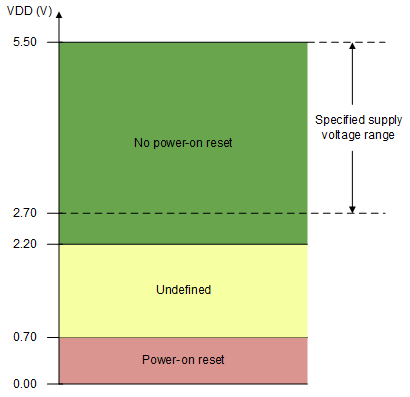ZHCSJ19E november 2018 – august 2023 DAC60501 , DAC70501 , DAC80501
PRODUCTION DATA
- 1
- 1 特性
- 2 应用
- 3 说明
- 4 Revision History
- 5 Device Comparison Table
- 6 Pin Configuration and Functions
-
7 Specifications
- 7.1 Absolute Maximum Ratings
- 7.2 ESD Ratings
- 7.3 Recommended Operating Conditions
- 7.4 Thermal Information
- 7.5 Electrical Characteristics
- 7.6 Timing Requirements: SPI Mode
- 7.7 Timing Requirements: I2C Standard Mode
- 7.8 Timing Requirements: I2C Fast Mode
- 7.9 Timing Requirements: I2C Fast-Mode Plus
- 7.10 Timing Diagrams
- 7.11 Typical Characteristics
- 8 Detailed Description
- 9 Application and Implementation
- 10Device and Documentation Support
- 11Mechanical, Packaging, and Orderable Information
8.3.3 Power-On-Reset (POR)
The DACx0501 family of devices includes a power-on reset (POR) function that controls the output voltage at power up. After the VDD supply has been established, a POR event is issued. The POR causes all registers to initialize to default values, and communication with the device is valid only after a 250-µs POR delay. The default value for the DAC data registers is zero-code for the DACx0501Z devices and midscale code for the DACx0501M devices. The DAC output remains at the power-up voltage until a valid command is written to a channel.
When the device powers up, a POR circuit sets the device to the default mode. The POR circuit requires specific VDD levels, as indicated in Figure 8-2, to make sure that the internal capacitors discharge and reset the device at power up. To make sure that a POR occurs, VDD must be less than 0.7 V for at least 1 ms. When VDD drops to less than 2.2 V but remains greater than 0.7 V (shown as the undefined region), the device may or may not reset under all specified temperature and power-supply conditions. In this case, initiate a POR. When VDD remains greater than 2.2 V, a POR does not occur.
 Figure 8-2 Threshold Levels for VDD POR Circuit
Figure 8-2 Threshold Levels for VDD POR Circuit